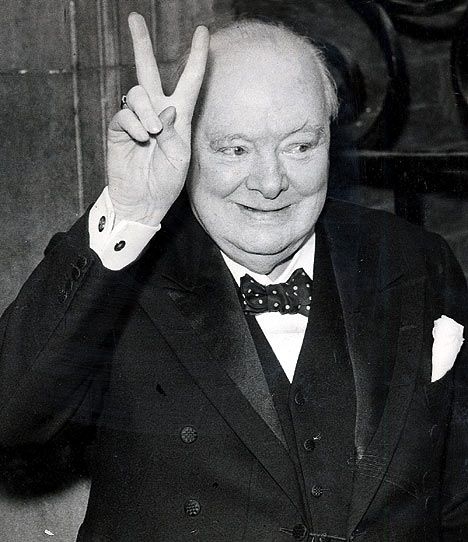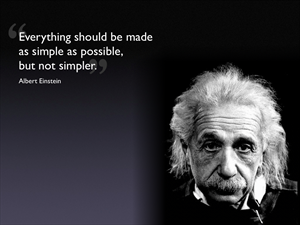Behavior 8: Churchill
Was a National Leader,
Not a Party Leader
May 2010 saw the installation of the first coalition government in the UK since the time of Churchill. This time, the electorate was divided between the two major parties so that neither party had a majority.
Churchill’s rise to Prime Minister was a different climb. The short story is that Neville Chamberlin resigned from office and King George assigned Churchill the job. To some of us “Yanks,” it seemed as though the king had said something like this: “Brilliant! Neville, please retire, you’re sacked. Churchill, you are in. Quick now, off you go and win the war, Winnie!” (You have to say it with a bit of a John Cleese accent).
No, it was much more. The wartime conditions and the leadership’s response to those conditions had to get much worse, and the people, the House of Lords, and the House of Commons had to turn on Chamberlain, the leader of the “appeasement” movement. For that change to happen, things had to get really bad.
The key to Churchill’s success is not that he ran a coalition government or that he was selected by the king. The real story is much more amazing, for he had to rise above party politics for the good of the country and the world. The political scene in May of 1940 was a battlefield as bad as any in the actual war. Party politics had ripped the heart out of good leadership, and it would take an amazing man with a singular focus to steer Britain to victory.
And he almost did not get the job.
To really understand the challenge, you have to understand the history that led up to it.
Appeasement
The memory of the First World War was still fresh in the minds of every adult in England. That war had been a political folly that killed a million British and wounded another 1.3 million. That’s 2.2 percent of the population killed and 3.7 percent wounded. The war left a deep psychic scar on the country. With that fresh in their minds, the people of England were in no mood for a fight in Europe. The same sentiment was also widespread in the United States.
The government of Neville Chamberlin sought out ways to stay clear of the war. Chamberlain famously flew to Berlin and made a pact with Hitler, declaring “peace in our time.” While most of the English public agreed with this policy of appeasement, many did not. Tensions built, and a deep political divide formed. It took the iron hand of Chamberlain and his thug of a party whip, David Margesson, to keep the appeasement policy intact.
The events that led to Chamberlain’s downfall and to King George installing Churchill as Prime Minister were helped along by a disorganized group of Tory rebels who were openly opposed to the government’s appeasement policy. In a letter to Churchill, Harold Macmillan described this restless group of young Conservative politicians as “troublesome young men,” and they kept up the pressure until history dealt them the right hand.
In our time, with the perspective of history, Chamberlain’s appeasement policy looks like insane, willful self-delusion. But at the time, it was the opponents of appeasement who were painted as crazy, war-mongering fools who would drag Britain into a conflict that could easily be avoided. The dissident opinions of Churchill, Macmillan, and the core group of “troublesome young men” faced not only the withering scorn of their peers, but the ruthless retaliation of Chamberlain’s thug, Margesson. Chamberlain played party politics for keeps, attacking his critics with a full bag of dirty tricks: spying, wiretapping, denial of advancement, and other cutthroat parliamentary politics.
Still, under this withering attack, the “troublesome young men” stood their ground. The machinery of the state was stacked against them, as were most of the press and the BBC. Reporters who wanted to report the buildup of German forces found their work unpublished by editors who feared provoking Hitler or Chamberlain. Churchill, who was regarded as a gifted orator but politically unreliable and emotionally unstable, turned down invitations to lead the challenge to appeasement, tempering his criticism of Chamberlain and waiting for the right time. When he entered the government, as the First Lord of the Admiralty in 1939, he would leave the plotting to others.
Things had to get much worse before the overmatched, anti-appeasement Tories could move. As things got worse, each debacle shifted public opinion, added converts to the movement, and turned the tide. After British forces were routed in Norway, the general public had the “sudden and paralyzing revelation that Chamberlain was a vain old man with nothing up his sleeve.” On May 8, during a brutal Parliamentary debate, Chamberlain lost control of the House of Commons and his government was voted out of power, bringing appeasement to an end.
Into the Breach
When Chamberlain resigned there were no opposition leaders left without the stain of bad blood on them, except for Churchill. When he took office, Churchill understood that to win the “real” war, the war of politics had to end quickly. Even though the two parties had agreed to form a wartime coalition party, there was still a great deal of political bickering going on, and Churchill knew it had to stop.
His plan: choose the ablest men from either party and from outside the political spectrum to join his war cabinet. It was a brave move and just the move that needed to be made to defuse the political war. To make it really work, he invited not only members of the opposition party, but even his bitter political enemies, telling them to focus the steam of their anger on the Nazis, and not on one another. His war government included Labour party leader Herbert Morrison as Home Secretary, and Chamberlain and Clement Attlee (at different times) as Lord of the Council. Attlee also served as Deputy Prime Minister, and Ernest Blevin served as Minister of Labor.
By including these political enemies in his war cabinet, Churchill could assimilate them into the fabric of the wartime effort. The move was also meant to keep them busy, for Churchill understood that idle hands create mischief.
To keep the peace, Churchill maintained a strong stance of “England First,” and was quick to discipline or remove anyone creating political tension. He was able to maintain this political “peace” for as long as the war lasted, but as soon as the war ended the coalition dissolved and Churchill found himself out on the street.
How Does Churchill’s Example Apply to Today’s Supply Chain?
Ask yourself this question: how often do you see decisions made in your company for political reasons, or to support a boss or a preferred subordinate? As much as we would like to say, “not in my company,” the fact is that it happens in all organizations. Tension between people in leadership functions is natural. We have a competitive nature that drives us, and office politics is but one result of that competitive spirit.
Truly gifted and effective leaders recognize the political issues and work to defuse them or minimize their impact. This is accomplished with integrity, fairness, honest speaking, and honest actions. Politically motivated corporate leaders do not thrive in healthy organizations, and organizations ruled by political intrigue do not survive.


